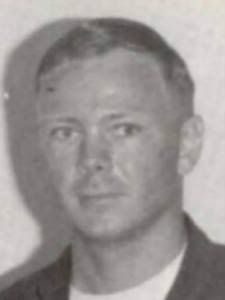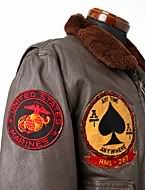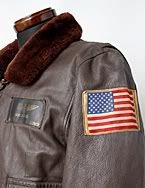-
When you click on links to various merchants on this site and make a purchase, this can result in this site earning a commission. Affiliate programs and affiliations include, but are not limited to, the eBay Partner Network.
You are using an out of date browser. It may not display this or other websites correctly.
You should upgrade or use an alternative browser.
You should upgrade or use an alternative browser.
Why are almost all vintage G-1's without patches ?
- Thread starter Curahee
- Start date
CBI
Well-Known Member
Roger is a forum member, you can ask him: rpmooreii
Lots of G-1's have patches but the nice thing is that one can locate almost any USN/USMC squadron patch on the bay and add it to the jacket. I know some say "never patch an original" but why not? I think many USN/USMC nameplates get removed post service and maybe folks go ahead and remove patches seeing as the jackets look a bit "off" with squadron patches and no nameplate.
Lots of G-1's have patches but the nice thing is that one can locate almost any USN/USMC squadron patch on the bay and add it to the jacket. I know some say "never patch an original" but why not? I think many USN/USMC nameplates get removed post service and maybe folks go ahead and remove patches seeing as the jackets look a bit "off" with squadron patches and no nameplate.
CBI said:Roger is a forum member, you can ask him: rpmooreii
Lots of G-1's have patches but the nice thing is that one can locate almost any USN/USMC squadron patch on the bay and add it to the jacket. I know some say "never patch an original" but why not? I think many USN/USMC nameplates get removed post service and maybe folks go ahead and remove patches seeing as the jackets look a bit "off" with squadron patches and no nameplate.
I would never patch an original because then it wouldn't be an original anymore
I can understand however replacing a broken zipper for an original replacement but
putting patches on it never ! On a repro that's something entirely else.
dav3469
Active Member
I'm wondering if maybe it may be a situation that many of those who are issued the G-1, have also been issued Nylon jackets as well. Such as WEP in earlier years and the CWU (?) types currently used. I have seen a great deal of Nylon jackets "patched out" being worn by Navy flyers.
Maybe many "patch out" the nylon and keep the leather jacket in nice "non punctured" condition??
Maybe many "patch out" the nylon and keep the leather jacket in nice "non punctured" condition??
You will notice on my site that many of my G-1s have had patches but they were removed (I assume by the vet). As to patching, I tend not to with on exception: I have a 1961 Edwards B (my birth year) that I patched with some of my Dad's (career aviator 1949-75) original patches and name tag... kind of a tribute to his service on a rare jacket from my birth year. I never really wear it though because I am a bit self conscious about walking around in public with a patched jacket even if they are from my dad's actual service.
...Roger
...Roger
I know what you mean with the self conscious thing. As you may know (vintage section) I have
a Gregory Sportswear 7823 D (real mouton) dated 1967 wich belonged to Lt. Mike Justus all
patched up and including a nametag. And it does feel a little strange at times, on the other
hand I keep a little part of history alive. But putting on more patches.....? no way that would
feel like sacrelige and not a tribute to a marine who died serving his country.
a Gregory Sportswear 7823 D (real mouton) dated 1967 wich belonged to Lt. Mike Justus all
patched up and including a nametag. And it does feel a little strange at times, on the other
hand I keep a little part of history alive. But putting on more patches.....? no way that would
feel like sacrelige and not a tribute to a marine who died serving his country.
unclegrumpy
Well-Known Member
The main reason most jackets don't have patches is that they were not the individuals, but rather the Squadron's property, and had to be returned as issued. Many were issued and turned back in the same day with the rest of the gear used for that flight.
Before the 1980's, it was very hard for an Enlisted man to acquire a jacket he could keep. You had to be on permanent flight status. Even with that, you probably would have to turn in your jacket when you left the Squadron, and if it had your patches on it, off they would come and it would be reissued to someone else. If you wanted to keep your jacket, you would have to buy it, and why do that when you knew when reported to your new assignment you would probably get a new jacket issued to you. Plus, that cost money...money you did not have.
Officers, especially pilots, were able to hold on to their jackets longer. That was largely because as a general rule, they did not always turn back in the more individual fitted items, like their flight helmet, oxygen mask, flight suits, gloves and jacket when they changed assignments. The theory was they always needed to have the basics with them to be able to jump into a plane and go. Jackets were also usually accounted for differently. They might be listed in the Officer's flight log book or in his personal jacket....which is not a flight jacket, but rather his military file, instead of being listed on the Squadron's account books.
Since a it was Government Property, an Officer would still have to eventually account for his flight jacket when he left the service. If he was going directly into the Reserves and staying on flight status, he probably would continue to keep his individual gear and including his jacket. If he was not, he would be facing the choice of either buying or turning his jacket in. However, if the Pilot was retiring Navy Captain or Commander, the Squadron's Chief Storekeeper might look the other way, and find a more creative accounting solution for his CO's jacket.
That all said, I also know from asking many Navy Vet's over the years, both Officer and Enlisted, the all important question: "So, do you still have your flight jacket....that one in the picture there with all the patches?" and got the answer...."No, I had to turn it in"....that that was another jacket that got stripped of all it's patches and thrown back onto the pile.
I think in summary, the vast majority of jackets either never had patches or were turned in and the patches taken off, and that is why we see so few originally patched jackets today.
Before the 1980's, it was very hard for an Enlisted man to acquire a jacket he could keep. You had to be on permanent flight status. Even with that, you probably would have to turn in your jacket when you left the Squadron, and if it had your patches on it, off they would come and it would be reissued to someone else. If you wanted to keep your jacket, you would have to buy it, and why do that when you knew when reported to your new assignment you would probably get a new jacket issued to you. Plus, that cost money...money you did not have.
Officers, especially pilots, were able to hold on to their jackets longer. That was largely because as a general rule, they did not always turn back in the more individual fitted items, like their flight helmet, oxygen mask, flight suits, gloves and jacket when they changed assignments. The theory was they always needed to have the basics with them to be able to jump into a plane and go. Jackets were also usually accounted for differently. They might be listed in the Officer's flight log book or in his personal jacket....which is not a flight jacket, but rather his military file, instead of being listed on the Squadron's account books.
Since a it was Government Property, an Officer would still have to eventually account for his flight jacket when he left the service. If he was going directly into the Reserves and staying on flight status, he probably would continue to keep his individual gear and including his jacket. If he was not, he would be facing the choice of either buying or turning his jacket in. However, if the Pilot was retiring Navy Captain or Commander, the Squadron's Chief Storekeeper might look the other way, and find a more creative accounting solution for his CO's jacket.
That all said, I also know from asking many Navy Vet's over the years, both Officer and Enlisted, the all important question: "So, do you still have your flight jacket....that one in the picture there with all the patches?" and got the answer...."No, I had to turn it in"....that that was another jacket that got stripped of all it's patches and thrown back onto the pile.
I think in summary, the vast majority of jackets either never had patches or were turned in and the patches taken off, and that is why we see so few originally patched jackets today.
chancerider
Member
I am pretty certain that the Marines had a "No patch" policy throughout WWII...if you look at period pictures of Marine pilots...you won't see patched jackets. The Navy had a similar policy, which they lightened up on beginning in the mid-50's as an esprit de' corps thing.
unclegrumpy
Well-Known Member
I have never heard of the Marines having a "no patch policy" in WW II. I know in all the Services, the wearing of patches and what they looked like, was subject to the discretion of the Unit or Theatre Commanders.
One reason you do not see too many patched USMC or USN leather jackets from WW II was it was too hot for them to wear them. If you look in Jeff Millstein's excellent book "U.S. Marine Corps Aviation Unit Insignia 1941-1946", you will see photos of at least ten patched leather jackets, plus photos of a number of original patches that clearly have been removed from jackets. This is by far the best book on the subject, and a "must have" if you are interested in studying real USMC patches from WW II.
I agree that you start to see more patched jackets starting in the Korean War era, but I think that is more due to the colder flying conditions and the easy access to having high quality custom made patches cheaply made in Japan. There were some fantastic patches made in this period, and getting something nice made representing your Unit was defiantly the thing to do.
http://www.amazon.com/Aviation-Insignia ... 185&sr=1-6
One reason you do not see too many patched USMC or USN leather jackets from WW II was it was too hot for them to wear them. If you look in Jeff Millstein's excellent book "U.S. Marine Corps Aviation Unit Insignia 1941-1946", you will see photos of at least ten patched leather jackets, plus photos of a number of original patches that clearly have been removed from jackets. This is by far the best book on the subject, and a "must have" if you are interested in studying real USMC patches from WW II.
I agree that you start to see more patched jackets starting in the Korean War era, but I think that is more due to the colder flying conditions and the easy access to having high quality custom made patches cheaply made in Japan. There were some fantastic patches made in this period, and getting something nice made representing your Unit was defiantly the thing to do.
http://www.amazon.com/Aviation-Insignia ... 185&sr=1-6
unclegrumpy
Well-Known Member
Very nice. That Marine must have kept his jacket a safe distance from his helicopter so as not to risk soiling it!
Mike Justus died at a very young age of 23 in 1970 during a midair crash when two AH-1Cobra helicopters (mike was the copilot) made a victory break comming back after a mission. He craduated from the Army Flight School (flight class 69-12) in may of 1969. He started his tour in Vietnam in october that year and died march 1970. His unit was the HMLA-367. His service record states that he was a "reserve component of the U.S. Marine Corps". He wore a Gregory Sportswear INC 7823D dated 1967.I bought the jacket in Osaka Japan, how it endedup there is a mystery to me.

SEMPER FI !

SEMPER FI !
unclegrumpy
Well-Known Member
What a historical jacket!
One rarely gets to learn where their jackets have been, and this G-1 has a very sad but interesting story. I bet the reason it is in such nice shape is it wasn't worn much in the months between when Lt Justus got it after flight school, and when he crashed. It would have been too hot in Vietnam to wear it.
It probably got sent home to his family with his personal effects after he was killed and that is why it survived as he wore it today. How it got to Japan could be anyone's guess.
One rarely gets to learn where their jackets have been, and this G-1 has a very sad but interesting story. I bet the reason it is in such nice shape is it wasn't worn much in the months between when Lt Justus got it after flight school, and when he crashed. It would have been too hot in Vietnam to wear it.
It probably got sent home to his family with his personal effects after he was killed and that is why it survived as he wore it today. How it got to Japan could be anyone's guess.
Latest posts
-
Painted A-2 Cost/Recommendations
- Latest: flyincowboy
-
-
-


